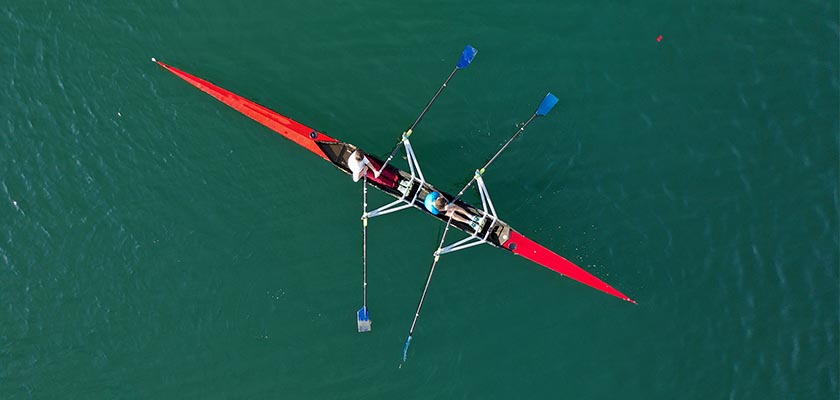The rules of paralympic rowing are very similar to those of the original sport, but it has some particularities to meet the needs of the athletes involved. Check out everything you need to know with our complete guide.
It is the International Paralympic Committee (IPC), which coordinates the Paralympic Games and oversees the development of the Paralympic movement worldwide, that is responsible for the rules of Paralympic rowing.
The IPC then establishes general guidelines for paralympic sports, including paralympic rowing, and works closely with the international federations of each sport to develop and implement the specific rules for each discipline.
Participate in our free WhatsApp community and receive daily tips, news and trivia from over 50 sports! Click here to join.
Paralympic rowing rules: objective
The objective of Paralympic rowing (also called adapted rowing) is to cross the finish line before the other boats. The course is 2,000m in a straight line.
There is no scoring system like in some other sports, where points are scored through goals, baskets or other forms of achievement during the game.
Paralympic rowing rules: penalties
The penalties in Paralympic rowing are applied to ensure safety and fairness during races.
One of these is a false start. That is, if a boat starts rowing before the start signal or moves before the umpire’s command.
Blocking or interfering with another boat’s progress during the race is considered obstruction and can also result in penalties such as warnings, time penalties or disqualification, depending on the severity of the infraction.
Using equipment that doesn’t fit in, such as oars or improperly modified boats, can also result in penalties (and, indeed, even disqualification of the team).
Paralympic rowing rules: classifications
The paralympic rowing athletes can have physical, visual or intellectual disabilities or limitations, and the only requirement is that they have minimum arm mobility.
To keep the competition fair, the qualifications in Paralympic rowing are based on the type of physical disability.
PR1
Athletes classified as PR1 have lower functional capacity and usually compete in boats with only one category of rowers. This means that each rower in a PR1 boat has a disability that significantly affects their physical function, such as total or partial paralysis of the legs and trunk.
PR1 rowers use adapted boats with fixed seats, as they may not have enough control or movement in their legs to use sliding seats. They may also use foot restraints or other adapted equipment, depending on the nature of their disability.
PR1
Athletes classified as PR2 have slightly greater functionality compared to PR1 athletes, but still face significant limitations. Generally, these athletes have some limited functionality in the legs and trunk, but can still perform broader and more coordinated movements.
PR2 rowers can use sliding seats and have greater control over the movement of their bodies compared to PR1 rowers.
PR3
Athletes classified as PR3 have the greatest functionality among the PR classifications, but still face physical limitations. They may have less severe physical disabilities, such as amputations or partial loss of muscle function, which affect their ability to perform certain movements.
PR3 rowers have a wider range of movements and physical abilities compared to PR1 and PR2 rowers.
Types of boats in Paralympic rowing
The paralympic rowing boats differ in the number of rowers and their purpose. Take a look at each one:
Single Scull (Skiff)
It’s a boat designed for a single rower. The rower uses two oars, one in each hand, and is responsible for controlling the balance and direction of the boat alone.
The Single Scull is characterized by its relatively low stability, which requires skill and balance on the part of the rower to avoid tipping over.
Double Skiff
A boat designed for two rowers, each with two oars, one in each hand. The rowers row side by side and must synchronize their movements to ensure effective rowing.
The Double Scull offers greater stability compared to the Single Scull, as two rowers share the effort of balancing and steering the boat.
Four
The Four boat is designed for four rowers, each with an oar. The rowers are distributed in two rows, with two rowers on each side of the boat.
It is a boat that offers greater stability and power compared to boats for fewer paddlers, allowing for faster and more efficient paddling.

Quad Scull
Similar to the Four, the Quad Scull is for four rowers, but each rower has two oars, one in each hand. The rowers row in pairs, with two rowers in each row.
Types of Paralympic rowing events
Male
- Single-Skiff PR1 (PR1 M1x)
Female
- Single-Skiff (PR1 W1x)
Mixed
- Double Skiff PR2 (PR2 Mix2x)
- Double Skiff PR3 (PR3 Mix2x)
- Quatro com PR3 (PR3 Mix4+)
How does paralympic rowing work?
So just to recap how Paralympic rowing works (adapted rowing): the aim is to reach the finish line before the other boats. Races can be held individually, in pairs or teams of four, and classifications are made according to the degree of disability of the athletes.
See how simple it is to understand the rules of paralympic rowing? To find out more about the world of sport, stay tuned to our content:





